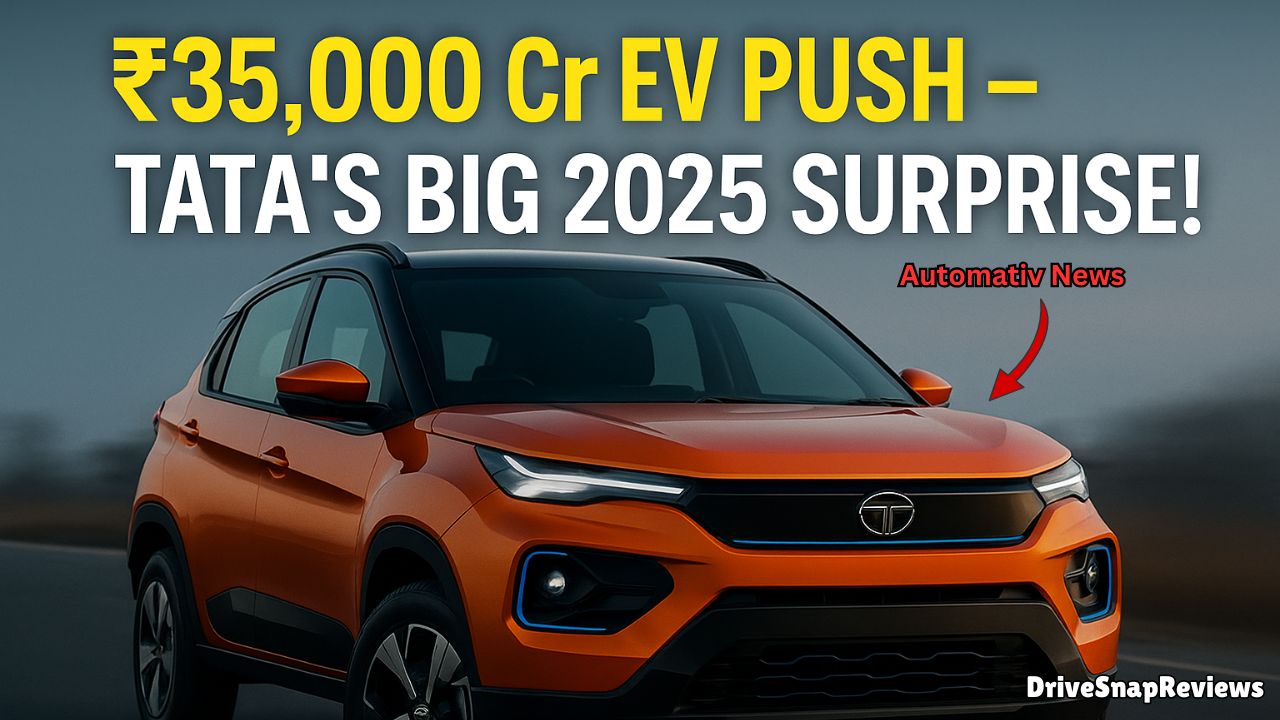Tata Motors EV 2025: ₹35,000 Cr Push for Nexon, Tiago & Punch EVs
Tata Motors EV journey is entering a bold new phase as the company announces a ₹35,000 crore investment to strengthen its electric vehicle portfolio. With growing focus on sustainable mobility, Tata Motors aims to expand models like the Tata Tiago EV and Tata Tigor EV Tata Motors lineup, making EVs more accessible to Indian customers. This massive push reflects Tata Motors EV strategy to dominate the future of clean transportation in India. What’s next? From upgraded models to new launches—here’s everything you need to know.
Tata Motors EV Investment 2025 – ₹35,000 Cr Plan Explained
Tata Motors EV strategy is set to redefine the Indian electric vehicle market, with a massive ₹35,000 crore investment plan for 2025 and beyond. This ambitious move aims to scale up Tata’s electric vehicle offerings and infrastructure significantly. The company plans to expand its EV portfolio from the current 8 models to 15 by 2030, focusing on innovation, better range, and advanced battery technologies. This includes key upgrades to popular models like the Tata Tiago EV and new versions of the Tata Tigor EV Tata Motors lineup, along with anticipated launches like the Harrier EV and Sierra EV.
As part of the investment roadmap, Tata will also strengthen its battery production and charging network across India. With this, Tata Motors EV not only targets leadership in the electric car segment but also aims to boost its overall market share to 18–20% by 2030. The ₹35,000 crore funding will cover everything from R&D, local manufacturing, and gigafactories to dealership and service upgrades—positioning Tata Motors as a future-ready EV brand for India’s rapidly growing sustainable mobility ecosystem.
What Is Tata Motors Planning for the EV Segment?
Tata Motors EV roadmap is not just about launching more electric cars—it’s a complete transformation of its passenger vehicle strategy. The company plans to introduce 10 new electric vehicles by 2025, expanding its EV lineup to 15 models by 2030. This includes a mix of hatchbacks, SUVs, and premium offerings like the upcoming Harrier EV and Sierra EV. Tata is also investing heavily in next-gen EV platforms, like the Gen 3 architecture, which will allow for better efficiency, longer range, and advanced connected features.
In the affordable EV segment, models such as the Tata Tiago EV and Tata Tigor EV Tata Motors are being upgraded with better range, fast-charging capabilities, and smarter tech integration. The company also plans to localize battery cell manufacturing through its gigafactory initiative, cutting dependency on imports. Additionally, Tata Motors is working on strengthening the charging infrastructure across India, making EVs more practical and convenient for everyday users. All these steps reflect Tata Motors EV ambition to not just compete—but lead—India’s electric revolution.
Nexon, Tiago, Tigor & Punch – Which EV Models Will Benefit?
Tata Motors plans to invest ₹35,000 crore in expanding its popular EV lineup. Key models such as the Nexon EV, Tiago EV, Tigor EV, and the all-new Punch EV stand to gain from India’s aggressive electric drive.
The Nexon EV, which retains the market leader in electric SUVs, will receive platform-level enhancements to improve range and battery efficiency. Tata intends to upgrade it to its superior Gen 2 EV architecture, resulting in smoother performance and greater driving characteristics. Meanwhile, the compact and cheap Tiago EV is receiving significant modifications, particularly in terms of battery capacity and charging speed, making it even more suitable for urban driving.

The Tigor EV, a top performer in Tata’s electric sedan portfolio, is slated to gain enhancements in amenities, safety, and battery range. Tata Motors is apparently improving connectivity features across all of its cars, and the Tigor EV will be no exception. The future Punch EV, on the other hand, will feature current EV style, a greater range, and a position between the Tiago and Nexon EVs. This will appeal to youthful, first-time EV purchasers searching for a compact but powerful electric SUV.
With all four models receiving next-generation improvements and better technology, Tata Motors’ EV plan clearly demonstrates a strong emphasis on product depth and customer satisfaction across all price segments.
How This ₹35,000 Cr Investment Will Impact Tata’s Future Cars
1. Next-Generation EV Platforms and Enhanced Performance
Tata’s investment will primarily support its acti.ev (Gen 2) and next Gen 3 skateboard systems, which are powered by electric motors. These platforms enable more efficient battery arrangement, resulting in increased range, cabin space, and performance. Nexon EV’s Gen 2 architecture enables larger battery packs (55 kWh+), resulting in over 400 km real-world range and faster acceleration than current models.
2. Superior Battery Technology and Faster Charging
In line with global trends, Tata Motors is establishing indigenous gigafactories to create cells for LFP and prismatic batteries, reducing reliance on imports and costs. Homegrown cells are intended to allow quicker DC charging (60-120 kW), lowering charging time to 20-60 minutes for 0-80% across models including Tata Motors’ Tiago EV and Tigor EV.
3. Improved Range and Real-World Efficiency
All EVs, from the Tiago to the Harrier, will have extended driving ranges thanks to smart platform design and improved batteries. The Nexon EV Max, similar to Nissan’s Yon exe, already achieves ~450km MIDC. Similar advancements are expected across the portfolio, solving consumer range-anxiety issues.
4. Increased driving comfort and premium features.
The expenditures also include suspension tuning, ADAS improvements, and interior technology. Tata’s Harrier EV has been upgraded with Level 2 ADAS, panoramic sunroof, 14.5″ QLED screens, and V2L/V2V technology, setting a new standard for mid-size electric SUVs. Expect similar capabilities to make their way down to younger models such as Tata Motors’ Nexon EV and Tigor EV.
5. Localized Production and Affordability
Manufacturing localization (cells, charging points, and EV-specific showrooms) will help to decrease costs, making EVs like the Tiago and Punch EV more affordable. The ₹35,000 cr infusion improves mass-market pricing and ensures Tata Motors’ EV ecosystem is accessible.
Tata Motors EV vs Competitors – Is Leadership Possible?
Tata Motors’ EV sector now dominates India’s electric vehicle market, accounting for 62-72% of sales. Tata has become the go-to brand for mainstream electric mobility thanks to inexpensive and reliable models such as the Tata Nexon EV, Tiago EV, and Tigor EV. However, the competition is heating up in 2025 and beyond.
Brands such as MG Motor and Mahindra Electric are fast growing. MG’s ZS EV and Comet EV have helped it capture more than 11% of the EV market, while Mahindra’s XUV400 and future Born-EV platforms target premium electric SUV shoppers. Meanwhile, Hyundai and Kia are contemplating Creta EV and EV6 upgrades, and Tesla’s India arrival may disrupt the premium EV category entirely.
Tata Motors’ EV strategy prioritizes investments of ₹35,000 Cr in local battery manufacturing, innovative EV platforms such as Gen 2 and Gen 3, and a future-ready product pipeline, including the Harrier and Sierra EVs. Tata also benefits from first-mover advantage in India’s EV charging infrastructure, which improves service accessibility across cities.
When Will Tata’s New EVs Launch in India?
Tata Motors EV lineup is rapidly expanding, and buyers are eagerly waiting for the next-gen electric cars. With models like the Punch EV already launched and vehicles like Harrier EV, Sierra EV, and Altroz EV on the way, Tata is preparing a future-ready electric portfolio. Here’s a detailed launch timeline of Tata’s upcoming EVs in India:
| Model | Expected Launch | Price Range | Key Features |
|---|---|---|---|
| Punch EV | ✅ Launched – Jan 2024 | ₹9.99 – ₹12.99 Lakh | 315–421 km range, fast charging, ADAS features |
| Harrier EV | ✅ Launched – June 2025 | ₹21.49 Lakh onwards | 627 km MIDC range, AWD, 14.5″ QLED display |
| Sierra EV | FY26 (Apr 2025 – Mar 2026) | ₹30 – ₹35 Lakh (expected) | Premium SUV, Gen 2 EV platform, off-road capable |
| Altroz EV | Late 2025 – Early 2026 | To Be Announced | Based on Gen 2 architecture, premium hatchback EV |
| Curvv EV | Mid–Late 2024 (Expected) | ₹15 – ₹18 Lakh (expected) | Stylish compact EV coupe, urban SUV crossover design |
Conclusion:-
Tata Motors EV strategy, which includes a ₹35,000 Cr investment plan and a strong EV portfolio, indicates long-term supremacy in India’s electric car market. Tata is developing an EV ecosystem based on local production, innovative battery technology, and smart connectivity, with models ranging from the economical Tiago EV and Punch EV to the premium Harrier EV and future Sierra EV.
The roadmap demonstrates that Tata is not slowing down—consistent EV releases through 2025 and 2026 will keep it ahead of competitors such as MG, Mahindra, and even global companies. Whether you’re looking for a low-cost EV or a high-performance SUV, Tata’s electric vehicles are designed to be future-ready, feature-rich, and value-oriented.
Tata Motors is doing more than just launching electric vehicles; it is rewriting the future of Indian mobility.
